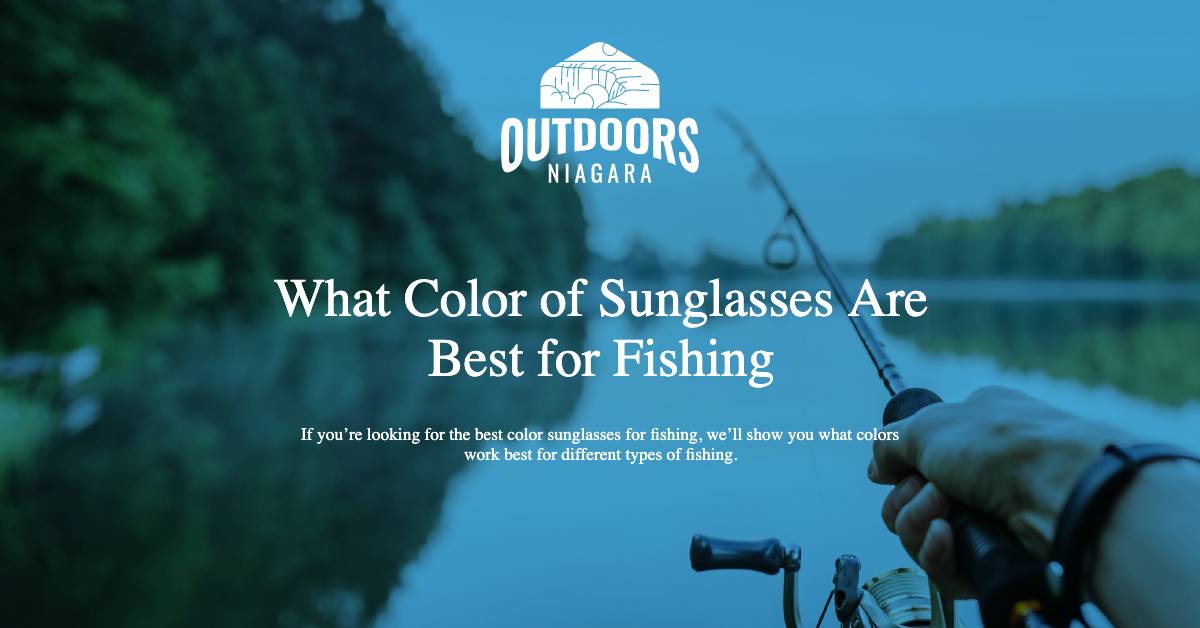Not only do quality a pair of sunglasses keep you stylish while you’re fishing, but they can also make it easier to see what’s around you.
The key is to use the right lens color for the type of fishing you’re doing.
By matching your lenses to the light conditions, you can become a better angler and maximize your daily catch.
Contents
What Color of Sunglasses Are Best for Fishing?
When it comes to choosing the right lenses, it’s best to consider what type of fishing you’ll be doing.
With that being said, amber, light brown, and copper lenses are great lens color choices if you’re looking for a general option for fishing.
Sunglasses for Fishing Color Chart
Sorted from bright-light to low-light situations.| Color Lens | Light Transmission | Light Condition | Fishing Location |
|---|---|---|---|
| Blue (gray base) | 10% | Bright, Full-sun | Open water and offshore |
| Green (copper & amber base) | 10% | Enhanced contrast and visions | Inshore and on flats |
| Gray | 12% | Everyday choice | On water and land |
| Silver (copper base) | 12% | Varying light situations | Stream fishing |
| Copper | 10% | Cuts glare in varying light situations | Sight-fishing to diving |
| Amber | 12% | Brightest field of vision and high contrast | Muskie anglers, etc. |
| Red (gray base) | 10% | Under normal light conditions, high contrast, cuts glare | Sight-fishing |
| Sunrise | 27% | Maximum light transmission | Dusk, dawn or cloudy environments |
Low Light vs Bright Light
Are you dealing with a low-light condition? Then use a copper-colored lens. The copper base offers 10-12% light transmission.
Grey lenses are also a great all-around choice for fishing.
Using grey lenses, the colors show normally with a tint of shade for a darker viewing experience.
If you’re sight-fishing then chose another color.
These brownish and blue hues will cut the blue light transmission and sharpen the contrasts in the water.
This, in turn, will make sight fishing easier than ever.
Polarized
Polarized sunglasses are especially useful because they cut the glare.
This will allow you to spot fish swimming under the surface. Once you’ve got your prey in your sights, you can plan your cast accordingly.
If you really want to maximize visibility, you should invest in special lenses for specific light conditions.
When the light is low due to clouds or the time of day, yellow or rose lenses will maximize visibility.
On sunny afternoons, a blue or green mirror lens can help keep the water glare at bay.
The gray base with these colors can perform a bit better for clearer waters with sunny conditions.
Material
The material of the lenses is also a factor.
While anglers have long favored glass lenses for their scratch resistance, new lens technology has seen plastic lenses become nearly as effective.
The lightness (thinness) of plastic lenses makes them a favorite for many anglers.
What are the advantages/disadvantages of polarized sunglasses?
Polarized lenses are specially designed to eliminate glare.
It’s worth noting mirrored lenses can further help with glare.
Without polarized sunglasses, the sunlight reflects off horizontal surfaces and into your eyes, making it difficult to see what’s going on around you.
By eliminating about 75% of this glare, polarized glasses can restore your vision on even the sunniest days.
Polarized glasses are useful for all sorts of activities, but they’re especially important when you’re fishing.
You can’t go fishing without water, and bodies of water just happen to form an especially reflective surface.
Without polarized lenses, the reflective glare will make it practically impossible to see beneath the ripples or waves.
Once you’ve got your polarized glasses in place, you can look below the surface without hurting your eyes.
The only real disadvantage to buying polarized sunglasses for fishing is the price.
With that being said, most anglers find the expense worthwhile.
Being able to see into the water can make it easier to spot fish, identify structures, and avoid getting stuck on the bottom.
All of this will make fishing a much more pleasant experience.
Are blue or green lenses better for fishing?
Both blue and green lenses are excellent choices for certain types of fishing.
This isn’t a case of one color being better than another.
It’s simply a matter of deciding which color is right for you.
Blue lenses, especially blue mirror lenses, are ideal for the bright conditions you could face when offshore fishing on a sunny day.
If you’re heading offshore where the sun is relentless and shade is nowhere to be found, you’ll be dealing with some serious water glare.
A blue mirror lens will cut that glare and give you the chance to see below the surface.
This can come in handy when fighting a fish close to the hull of the boat.
Green mirror lenses, meanwhile, are better for inshore fishing.
They do an excellent job of cutting through brown or murky water.
When you’re fishing in a river or shallow lake, this extra visibility will make sight fishing possible.
After spotting fish lurking in the shallows, you’ll be able to cast right into them.
What color sunglasses for fly fishing?
Lenses with a brownish hue are generally best for inshore fly fishing.
When you’re working with small streams and shallow water, you need glasses that provide both definition and relief.
Amber, copper, and bronze lenses will give you this effect.
They’re also wonderfully versatile, meaning they’ll serve your purpose in any weather and at any time of day.
Offshore fly fishing, of course, brings its own needs. If you’re going to be out at sea, you’re better off using the blue mirror lenses that so effectively cut the midday reflective glare.
What color sunglasses for inshore beach fishing?
If you’re going to be surfcasting during the day, then you should expect to deal with a fair amount of glare.
On a sunny day, the ocean acts like a giant mirror.
To follow your plug without hurting your eyes, you’ll need to use the right type of polarized fishing sunglasses.
Gray lenses do an excellent job of cutting all-around glare.
This makes them a great choice for anyone spending hours out on the beach.
They are also quite neutral, meaning they won’t alter the natural appearance of the water.
Amber lenses, with their versatility and contrast, provide another great option.
What are the best color polarized sunglasses for muskie fishing?
Most muskie anglers prefer the versatility and utility of amber lenses.
When spending a day out on the water, the conditions are sure to change.
A sunny sky can give way to overcast conditions in a matter of minutes.
Amber glasses effectively cut the glare in all situations, making them a great overall choice.
You can also prepare yourself for any circumstances by investing in multiple pairs of sunglasses for fishing.
With an amber pair for low-light situations and a blue mirror pair for bright sunny days, you’ll be ready for whatever nature could throw at you.
When it comes to muskie fishing, the most important thing is that your sunglasses are polarized.
Not only is sight fishing for muskie an effective strategy, but it’s also loads of fun.
Conclusion
If you choose the right pair of sunglasses, you should be able to catch lots of fish and look good doing it.
The key is to consider the type of fishing you’ll be doing, under certain light conditions, before you make your choice.
The color of the sunglasses affects the light transmission, allowing you to better see whilst fishing.
Now that you know the basics, you should have no trouble choosing the lenses that are right for you.







